Non-Small Cell Lung Cancer (NSCLC) Market Size
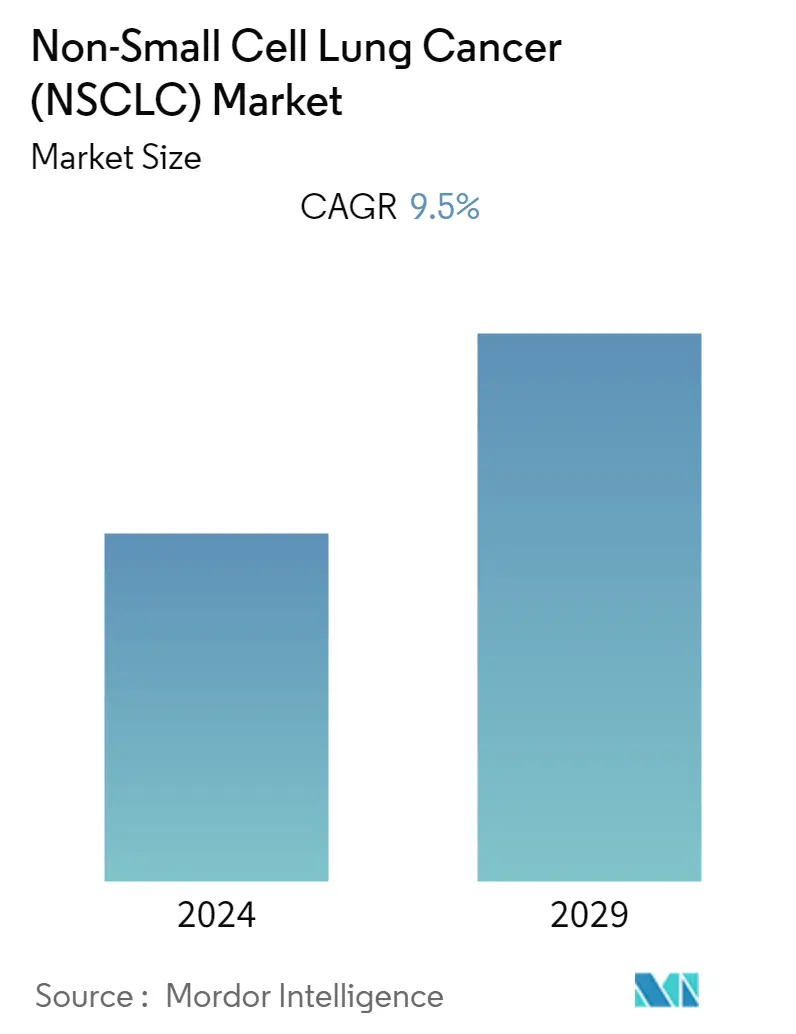
| Study Period | 2019 - 2029 |
| Base Year For Estimation | 2023 |
| Forecast Data Period | 2024 - 2029 |
| CAGR | 9.50 % |
| Fastest Growing Market | Asia-Pacific |
| Largest Market | North America |
Major Players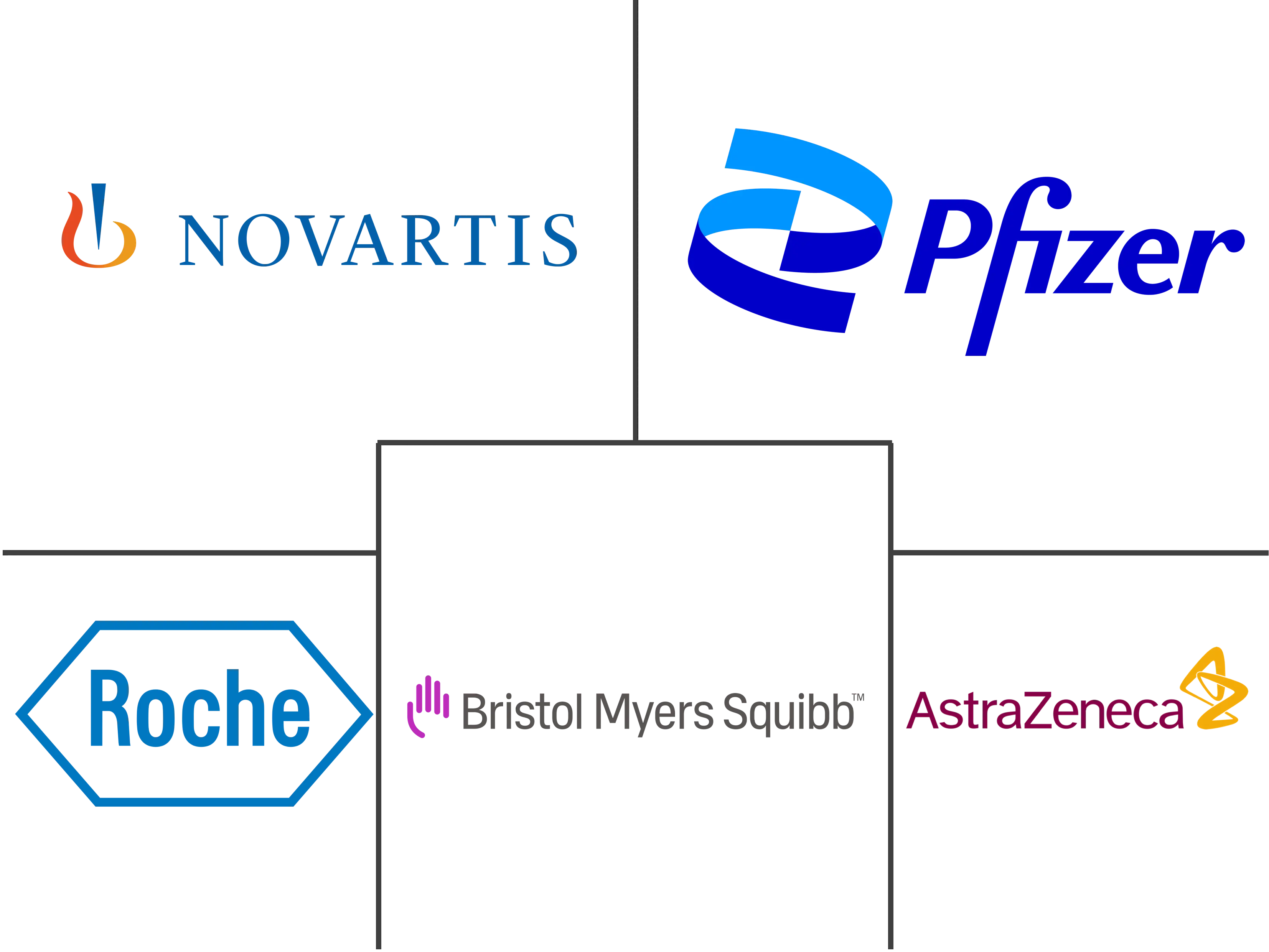
*Disclaimer: Major Players sorted in no particular order |
Need a report that reflects how COVID-19 has impacted this market and its growth?
Non-Small Cell Lung Cancer (NSCLC) Market Analysis
The non-small cell lung cancer (NSCLC) market is expected to register a CAGR of 9.5% during the forecast period.
COVID-19 has significantly affected the growth of the non-small cell lung cancer market. For instance, as per clinicaltrials.gov, as of July 2021, more than 200 interventional studies were halted during the pandemic. This has slowed down the market growth during the pandemic. However, with the released restrictions and resumed services, the company has increased its focus on conducting clinical trials for the treatment of non-small cell lung cancer. For instance, in October 2022, Daiichi Sankyo, Inc. in partnership with AstraZeneca is conducting a Phase II clinical trial to evaluate the safety and efficacy of trastuzumab deruxtecan in HER2-mutated metastatic non-small cell lung cancer (NSCLC). Thus, with such activities, the studied market is expected to grow over the forecast period.
The growing number of patients suffering from non-small cell lung cancer and the increasing number of people with unhealthy habits such as smoking, tobacco and alcohol consumption, high dose of supplements, and sedentary lifestyle across the world are driving the market growth. For instance, according to the news published in December 2022, globally about 2.20 million new cases are among 11.4% of total thoracic tumor cases and this number is projected to double by 2025. Also, as per the data published by National Cancer Registry Programme (ICMR-NCRP), in December 2022, the number of lung cancer cases increased from 98,278 in 2020 to 1,03,371 in 2022, representing an increase of 5%. Thus, the high burden of lung cancer among the population has increased the demand for effective treatment options, which in turn is anticipated to fuel market growth.
Furthermore, the increasing company's focus on conducting R&D of effective drugs for the treatment of NSCLC and the increasing product approvals and various therapy designations are contributing to the market growth. For instance, in October 2022, GSK plc reported positive results from PERLA, the phase II trial of Jemperli (dostarlimab) plus chemotherapy in patients with metastatic non-squamous non-small cell lung cancer. Also, in June 2022, the European Commission approved Novartis's Tabrecta (capmatinib) as a monotherapy for the treatment of adults with advanced non-small cell lung cancer (NSCLC) who require systemic therapy following before treatment with immunotherapy and/or platinum-based chemotherapy. Similarly, in February 2022, the Medicines and Healthcare Products Regulatory Agency (MHRA) approved Genentech's Tecentriq to treat early-stage non-small cell lung cancer.
Moreover, the increasing investment by companies in developing effective therapies for treating patients with lung cancer is also expected to fuel market growth. For instance, in January 2023, DeuterOncology, a clinical-stage drug development company, closed EUR 5.65 million (USD 6.1 million) Series A financing round. This funding enables the company to initiate the phase I clinical study for its lead product DO-2, an improved MET kinase inhibitor that is being developed as a potential best-in-class targeted therapy for lung cancer. MET inhibitors have recently been approved for patients with Non-Small Cell Lung Cancer (NSCLC) harbouring the MET exon 14 skipping mutant.
Therefore, owing to the factors such as the high burden of non-small cell lung cancer, growing R&D activities, and product approvals, the studied market is anticipated to grow over the forecast period. However, the high cost of therapy or drugs and low diagnosis rate in developing countries is likely to impede the growth of non-small cell lung cancer over the forecast period.
Non-Small Cell Lung Cancer (NSCLC) Market Trends
Targeted Therapy Segment is Expected to Hold Significant Market Share Over the Forecast Period
The targeted drug therapy segment is anticipated to witness significant growth in the market over the forecast period owing to the factors such as the rising incidence of non-small cell lung cancer, and increasing company activities for developing novel treatments.
Targeted therapy drugs are often used to treat advanced lung cancers and are either used along with chemotherapy or used individually. Some of the major targeted therapy drugs to treat non-small cell lung cancer are Erlotinib (Tarceva), Gefitinib (Iressa), Afatinib (Gilotrif), Mobocertinib (Exkivity), Osimertinib (Tagrisso), and Dacomitinib (Vizimpro). These drugs targets mutated genes in the body and thereby avoid adverse effect on healthy cells. Investment by market players in the development of targeted therapy due to its advantages over standard chemotherapy and entry of these drugs in multiple countries across the world are likely to drive market growth. For instance, in October 2021, AUM Biosciences completed USD 27 million in a Series A funding round. These funds are used to advance the company's clinical-stage pipeline of precision and targeted cancer therapies.
According to an article published by MDPI, in December 2022, precision medicine's emergence has shed light on the treatment of non-small cell lung cancer, increasing the options available to patients with advanced NSCLC by targeting therapy on genetic and epigenetic markers. Additionally, as per an article published in the Journal of Hematology and Oncology, in June 2021, it has been observed that patients receiving targeted therapy showed a significant improvement in progression-free survival as compared to patients receiving chemotherapy. Also, as per the same source, for patients who underwent targeted therapy and had EGFR, ALK, ROS1, and BRAF mutations, the response rate ranged from 50% to 80%. Thus, the effectiveness of targeted drug therapy increases their adoption as well as demand for treating patients with NSCLC, hence propelling the segment growth.
Furthermore, the rising targeted therapy product approvals increase the availability of novel therapeutic drugs in the market which is also anticipated to augment the segment growth over the forecast period. For instance, in August 2022, AstraZeneca and Daiichi Sankyo's Enhertu, a targeted therapy, was approved in the United States for the treatment of adult patients with unresectable or metastatic non-small cell lung cancer whose tumors have activating HER2 (ERBB2) mutations. Also, in May 2021, the US FDA approved Rybrevant (amivantamab-vmjw) as the first targeted therapy treatment for adult patients with non-small cell lung cancer whose tumors have specific types of genetic mutations such as epidermal growth factor receptor (EGFR) exon 20 insertion mutations.
Therefore, owing to the factors such as the rising research activities by companies and institutions, growing adoption of targeted drug therapy treatment, and increasing product approvals, the studied segment is anticipated to grow over the forecast period.
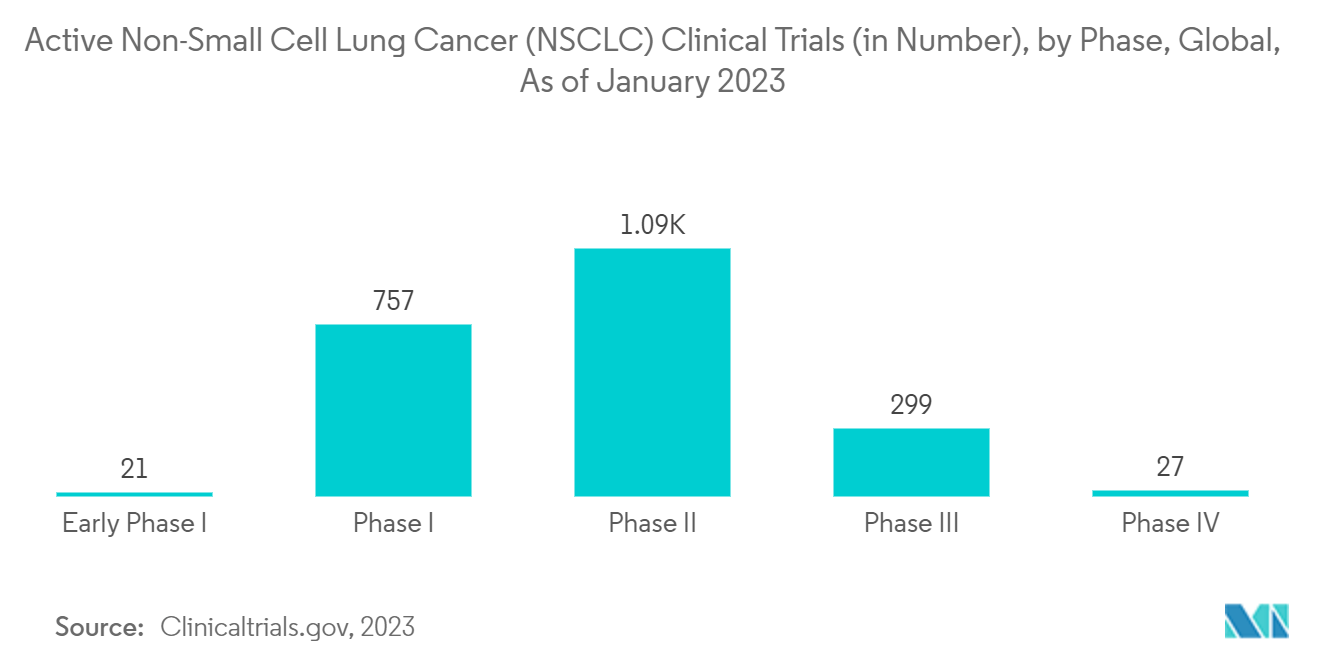
North America is Expected to Have the Significant Market Share Over the Forecast Period
North America is expected to witness significant growth in the market over the forecast period owing to the factors such as the rising number of non-small cell lung cancer among the population and the presence of key players in the region focusing on launching and gaining approvals from the authorities. In addition, the increasing R&D investment by the players and huge healthcare spending in the region is also contributing to the market growth.
The increasing burden of NSCLC among the population is the key factor driving the market growth in the region. For instance, according to the 2023 statistics published by ACS, about 238,340 new cases of lung cancer are expected to be diagnosed in the United States in 2023. Additionally, as per 2022 statistics published by the Canadian Cancer Society, approximately 30,000 Canadians were diagnosed with lung and bronchus cancer, accounted for 13% of all new cancer cases, in Canada, in 2022. Thus, the high number of people suffering from lung cancer fuels the demand for effective treatment therapies such as chemotherapy, targeted therapy, and others. This is anticipated to propel the market growth over the forecast period.
Additionally, as per the data published by Statistics Canada, in January 2022, lung cancer is the most often diagnosed cancer and the leading cause of cancer-related deaths in Canada. About 50% of lung cancer cases are discovered at stage IV when the chance of survival is incredibly low (4% over five years). Thus, the high burden of lung cancer mainly discovered at the last stage increases the demand for chemotherapy sessions along with effective drugs, which in turn is expected to boost the market growth over the forecast period.
Furthermore, the growing company activities and increasing product approvals are also expected to increase the market growth over the forecast period. For instance, in August 2022, Health Canada approved Bristol Myers Squibb's OPDIVO 360 mg (injection for intravenous use) in combination with platinum-doublet chemotherapy every three weeks for three cycles for adult patients with resectable non-small cell lung cancer (NSCLC) in the neoadjuvant setting. Also, in January 2022, the US FDA granted Breakthrough Therapy Designation (BTD) to AbbVie's investigational telisotuzumab vedotin (Teliso-V) for the treatment of patients with advanced/metastatic epidermal growth factor receptor (EGFR) wild-type, nonsquamous non-small cell lung cancer (NSCLC) with high levels of c-Met overexpression whose disease has progressed on or after platinum-based therapy.
Therefore, due to the aforementioned factors, such as growing product approvals and product launches as well as the increasing number of non-small cell lung cancer cases, the studied market is expected to grow over the forecast period.
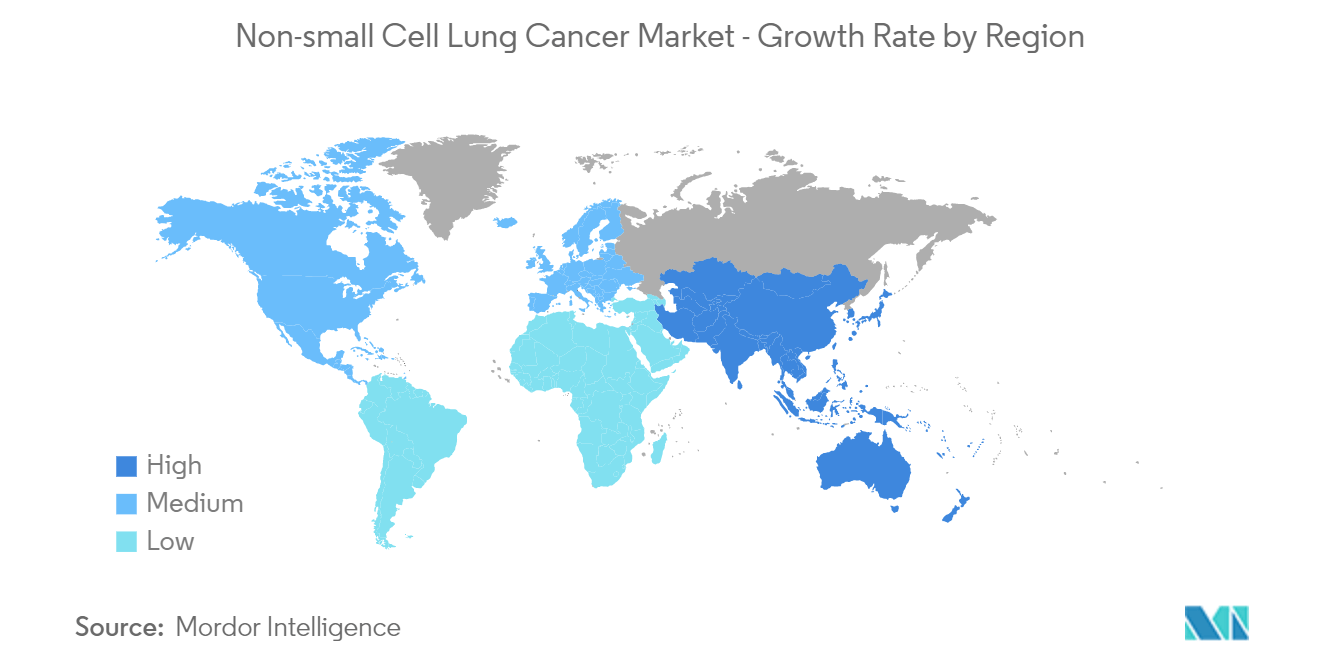
Non-Small Cell Lung Cancer (NSCLC) Industry Overview
The non-small cell lung cancer market is fragmented and competitive and consists of several major players. The companies are adopting various key business strategies such as collaborations, partnerships, new product launches and other initiatives to withhold their market position. Some of the key companies in the market are F. Hoffmann-La Roche, AstraZeneca, Bristol-Myers Squibb, Merck, Novartis, Pfizer, Takeda Pharmaceuticals, Bayer Healthcare, Eli Lilly and Company, and GlaxoSmithKline among others.
Non-Small Cell Lung Cancer (NSCLC) Market Leaders
-
F. Hoffmann-La Roche Ltd.
-
Bristol-Myers Squibb Company
-
Pfizer Inc.
-
AstraZeneca
-
Novartis AG
*Disclaimer: Major Players sorted in no particular order
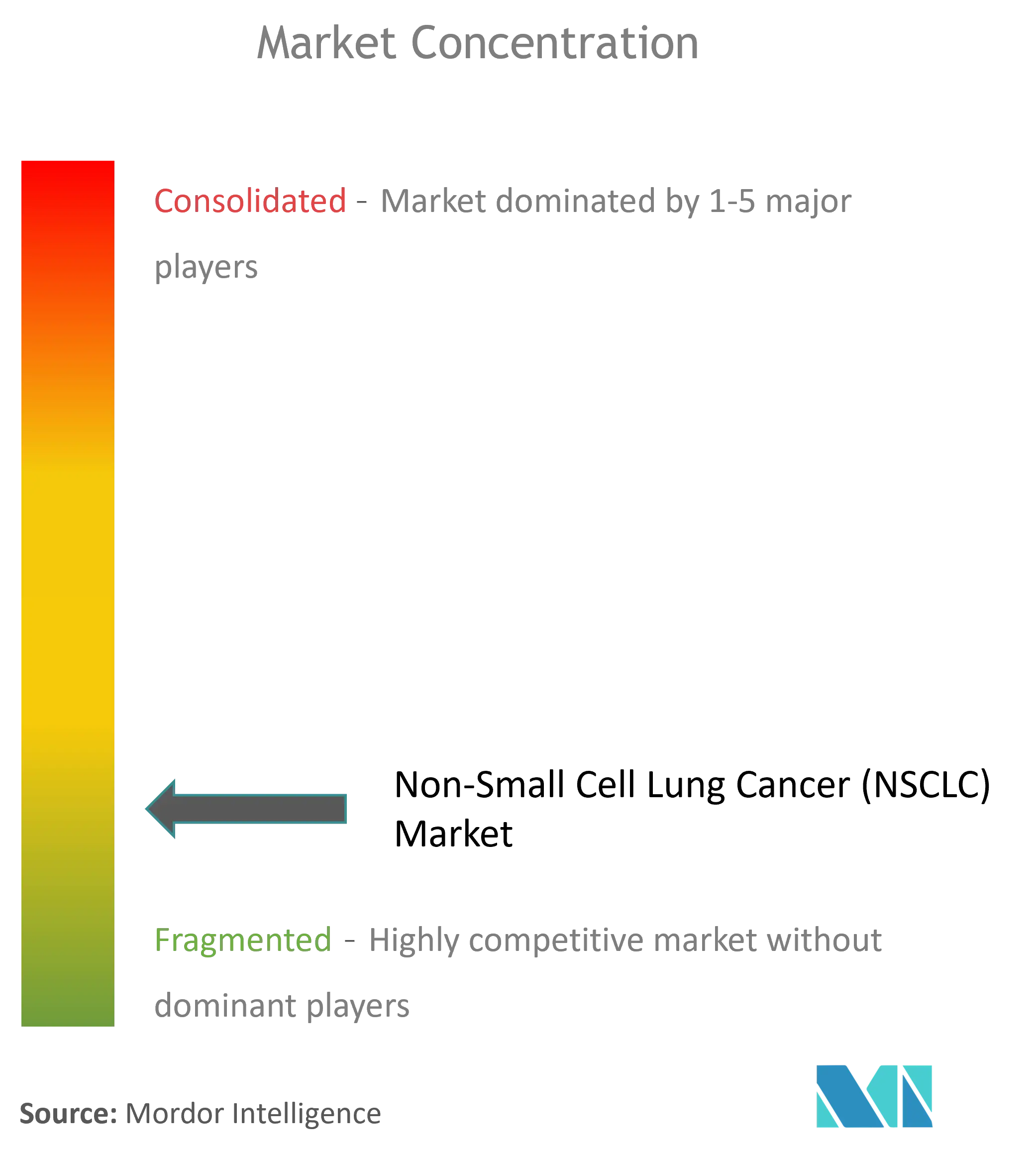
Non-Small Cell Lung Cancer (NSCLC) Market News
- In January 2023, Novocure reported that the LUNAR study evaluating the safety and efficacy of Tumor Treating Fields (TTFields) together with standard therapies for stage 4 non-small cell lung cancer (NSCLC) following progression while on or after treatment with platinum-based therapy, met its primary endpoint.
- In December 2022, the United States FDA granted accelerated approval to Mirati's Krazati (adagrasib), a targeted treatment option for adult patients with KRAS-mutated locally advanced or metastatic non-small cell lung cancer (NSCLC).
Non-Small Cell Lung Cancer Market Report - Table of Contents
1. INTRODUCTION
- 1.1 Study Assumptions and Market Definition
- 1.2 Scope of the Study
2. RESEARCH METHODOLOGY
3. EXECUTIVE SUMMARY
4. MARKET DYNAMICS
- 4.1 Market Overview
-
4.2 Market Drivers
- 4.2.1 Increasing Investment for the Development of New Therapy
- 4.2.2 Increasing Prevalence of NSCLC
-
4.3 Market Restraints
- 4.3.1 High Cost of Therapy/Drugs and Low Diagnosis Rate in Developing Countries
-
4.4 Porter's Five Forces Analysis
- 4.4.1 Threat of New Entrants
- 4.4.2 Bargaining Power of Buyers/Consumers
- 4.4.3 Bargaining Power of Suppliers
- 4.4.4 Threat of Substitute Products
- 4.4.5 Intensity of Competitive Rivalry
5. MARKET SEGMENTATION (Market Size by Value - USD million)
-
5.1 By Cancer Type
- 5.1.1 Squamous Cell Carcinoma
- 5.1.2 Adenocarcinoma
- 5.1.3 Large-cell Carcinoma
-
5.2 By Treatment
- 5.2.1 Chemotherapy
- 5.2.2 Targeted Therapy
- 5.2.3 Immunotherapy
- 5.2.4 Other Treatment Therapy
-
5.3 Geography
- 5.3.1 North America
- 5.3.1.1 United States
- 5.3.1.2 Canada
- 5.3.1.3 Mexico
- 5.3.2 Europe
- 5.3.2.1 Germany
- 5.3.2.2 United Kingdom
- 5.3.2.3 France
- 5.3.2.4 Italy
- 5.3.2.5 Spain
- 5.3.2.6 Rest of Europe
- 5.3.3 Asia-Pacific
- 5.3.3.1 China
- 5.3.3.2 Japan
- 5.3.3.3 India
- 5.3.3.4 Australia
- 5.3.3.5 South Korea
- 5.3.3.6 Rest of Asia-Pacific
- 5.3.4 Middle East and Africa
- 5.3.4.1 GCC
- 5.3.4.2 South Africa
- 5.3.4.3 Rest of Middle East and Africa
- 5.3.5 South America
- 5.3.5.1 Brazil
- 5.3.5.2 Argentina
- 5.3.5.3 Rest of South America
6. COMPETITIVE LANDSCAPE
-
6.1 Company Profiles
- 6.1.1 F. Hoffmann-La Roche Ltd.
- 6.1.2 AstraZeneca
- 6.1.3 Bristol-Myers Squibb Company
- 6.1.4 Merck & Co., Inc.
- 6.1.5 Novartis AG
- 6.1.6 Pfizer Inc.
- 6.1.7 Takeda Pharmaceutical Company Limited
- 6.1.8 Bayer AG
- 6.1.9 Eli Lilly and Company
- 6.1.10 GlaxoSmithKline plc.
- 6.1.11 Sanofi
- 6.1.12 Agennix AG
- *List Not Exhaustive
7. MARKET OPPORTUNITIES AND FUTURE TRENDS
** Subject To AvailablityNon-Small Cell Lung Cancer (NSCLC) Industry Segmentation
As per the scope of the report, non-small cell lung cancer is a type of epithelial lung cancer, excluding small-cell lung carcinoma. The Non-Small Cell Lung Cancer (NSCLC) Market is Segmented by Cancer Type (Squamous Cell Carcinoma, Adenocarcinoma, Large-cell Carcinoma), Treatment (Chemotherapy, Targeted Therapy, Immunotherapy, Other Treatment Types), and Geography (North America, Europe, Asia-Pacific, Middle East and Africa, and South America). The market report also covers the estimated market sizes and trends for 17 different countries across major regions, globally. The report offers the value (in USD million) for the above segments.
| By Cancer Type | Squamous Cell Carcinoma | |
| Adenocarcinoma | ||
| Large-cell Carcinoma | ||
| By Treatment | Chemotherapy | |
| Targeted Therapy | ||
| Immunotherapy | ||
| Other Treatment Therapy | ||
| Geography | North America | United States |
| Canada | ||
| Mexico | ||
| Geography | Europe | Germany |
| United Kingdom | ||
| France | ||
| Italy | ||
| Spain | ||
| Rest of Europe | ||
| Geography | Asia-Pacific | China |
| Japan | ||
| India | ||
| Australia | ||
| South Korea | ||
| Rest of Asia-Pacific | ||
| Geography | Middle East and Africa | GCC |
| South Africa | ||
| Rest of Middle East and Africa | ||
| Geography | South America | Brazil |
| Argentina | ||
| Rest of South America |
Non-Small Cell Lung Cancer Market Research FAQs
What is the current Global Non-Small Cell Lung Cancer (NSCLC) Market size?
The Global Non-Small Cell Lung Cancer (NSCLC) Market is projected to register a CAGR of 9.5% during the forecast period (2024-2029)
Who are the key players in Global Non-Small Cell Lung Cancer (NSCLC) Market?
F. Hoffmann-La Roche Ltd. , Bristol-Myers Squibb Company, Pfizer Inc. , AstraZeneca and Novartis AG are the major companies operating in the Global Non-Small Cell Lung Cancer (NSCLC) Market.
Which is the fastest growing region in Global Non-Small Cell Lung Cancer (NSCLC) Market?
Asia-Pacific is estimated to grow at the highest CAGR over the forecast period (2024-2029).
Which region has the biggest share in Global Non-Small Cell Lung Cancer (NSCLC) Market?
In 2024, the North America accounts for the largest market share in Global Non-Small Cell Lung Cancer (NSCLC) Market.
What years does this Global Non-Small Cell Lung Cancer (NSCLC) Market cover?
The report covers the Global Non-Small Cell Lung Cancer (NSCLC) Market historical market size for years: 2019, 2020, 2021, 2022 and 2023. The report also forecasts the Global Non-Small Cell Lung Cancer (NSCLC) Market size for years: 2024, 2025, 2026, 2027, 2028 and 2029.
Global Non-Small Cell Lung Cancer (NSCLC) Industry Report
Statistics for the 2024 Non-Small Cell Lung Cancer (NSCLC) market share, size and revenue growth rate, created by Mordor Intelligence™ Industry Reports. Non-Small Cell Lung Cancer (NSCLC) analysis includes a market forecast outlook to for 2024 to 2029 and historical overview. Get a sample of this industry analysis as a free report PDF download.

